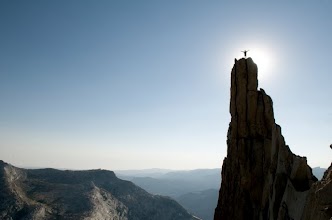Way More Than Riding
-by Linda ParelliThe toughest thing about relationships between prey animals (horses) and predators (humans) is the inherent fear that horses have of us, no matter how nice we are to them.
Something that will dramatically improve your relationship with your horse is spending undemanding time with them.
Think about it, unless you are feeding your horse, most times you approach him it’s because you want to ‘do’ something with him… even if it’s just grooming him, it is still something that is all about approach and this can become very unsettling and even disturbing for a horse. That’s what makes them hard to catch, resistant, hesitant, annoyed or afraid.
What you’re going to do in this exercise is prove to your horse that you don’t want anything from him and once you’ve proven this he’ll actually get the confidence to come up to you.
You’ll know you’re successful when your horse starts wanting to be next to you and stay next to you and even follow you around… and pretty soon he’ll be more excited to see you and start coming over to you rather than have to be caught.
If your horse is hard to catch, nervous, bracy or tense around you, spending undemanding time with him will be one of the most important things to do to change his negative perception of you.
INSTRUCTIONS FOR: Undemanding Time Exercise
How long you need
Set aside a full 30 minutes for this task and don’t do it at feeding time. Food in front of a hungry horse is hard to compete with!
What to do
Sit in your horse’s stable, pasture or pen. You can sit on the ground or have a chair and be comfortable. You can even read a book! The idea is not to focus on your horse at all, just be in the same space as him.
Quietly come through the door or gate, set yourself up and ignore your horse. When you want to peek at what he’s doing, do it in a casual way and get back to your book.
Simply do your 30 minutes and then leave.
Do not go up to your horse, don’t reach for him, don’t even think about it. Sometimes just the energy of your expectation or intention is enough to keep a sensitive horse away from you.
Undemanding time means you are asking nothing, just being there.
That might be very hard for you and you will learn a lot about yourself as well as help the relationship between you and your horse.
Likely reactions from your horse
In the first 1 – 4 sessions your horse might…
- Ignore you.
- Move as far away as possible from you.
- Turn his back to you.
- Stand facing you.
- Come check you out and then leave.
- Move around and around with worry.
- Try to get out of the gate.
- Come and sniff you.
- Approach and leave several times.
- Try to nibble at your toes or clothes, hair, etc.
- Nudge or try to paw at you in a curious way.
- Let out big breaths, start yawning even rolling (this is release of adrenaline / nervousness).
- Stand with his head over you, like a mare does with her foal.
- Fall asleep next to you, standing or lying down.
- Whinny when he sees you coming.
- Meet you at the gate.
How often to repeat it
You need to do this for seven sessions in a row. For the first three or four sessions you might feel like nothing is happening, but a lot is. You just don’t know it. Go through the whole seven and you’ll see things change so long as you’re following the directions properly.
Ideally, you wouldn’t do anything else in the same session. If you still intend to play with him after that, make your exit; wait for a minimum of five minutes (preferably a lot more) so it is a totally separate session with him.
After you’ve completed the seven sessions and your horse is more relaxed and trusting of you, you shouldn’t need to do this again unless all of a sudden something has caused your horse to revert. Then do it once or twice to balance the relationship out again.
Cautions
It is best that your horse is by himself and no other horses are able to get between him and you.
If he nibbles or paws at you allow the gentle stuff, but if it starts feeling uncomfortable for you, gently or more insistently wave your arms and legs until he backs off. You might want to stand up, but don’t go towards him. Do some jumping jacks if he’s getting pushy, but otherwise pet him and end the session.
If your horse is dangerous in any way then sit outside the gate. It might take more than seven sessions before he relaxes and gets more trusting, but the effect is the same.
If your horse is very self-confident and tends to push you around or is mouthy and overbearing, you cannot do the exercise by sitting with him because he might get overzealous and actually become demanding of you! This horse needs something to do, he doesn’t need to feel more confident around you, but maybe what you need to learn is how to become more interesting and provocative in your training sessions so he doesn’t get bored or naughty. Learn more about this by downloading the Horsenality Profile. Undemanding time with this horse can be achieved by grazing him, just hanging out and scratching his itchy spots.
If you try to do this with an aggressive or a wild horse, such as a newly adopted mustang it will take a lot longer than 7 sessions. It is not an efficient way to start, you need something way more powerful such as being the supplier of his water. If you are in the Savvy Club, type Catching into the search engine and learn how Pat Parelli does it. We advise novice horse owners not to attempt this.
 3. Be in love with what you want. FEEL the image. Emotions are essential. If you’re so-so about a dream, is it worth pursuing? No. If you’re not IN LOVE with your goal, why bother?
3. Be in love with what you want. FEEL the image. Emotions are essential. If you’re so-so about a dream, is it worth pursuing? No. If you’re not IN LOVE with your goal, why bother? 6. Believe. This is the hard one. Our logical minds want to know who, what, when, where and how. Once we entertain those questions, doubt creeps in and the struggle begins. Doubt is the beginning of the end. Quickly and deliberately bring your focus back to what you want. It’s not your job to figure out how. That will come on its own. You’ll have a flash of inspiration; the right people will cross your path; you’ll acquire a key skill at just the right time. It really doesn’t matter HOW you achieve. Just have unwavering faith THAT you will achieve.
6. Believe. This is the hard one. Our logical minds want to know who, what, when, where and how. Once we entertain those questions, doubt creeps in and the struggle begins. Doubt is the beginning of the end. Quickly and deliberately bring your focus back to what you want. It’s not your job to figure out how. That will come on its own. You’ll have a flash of inspiration; the right people will cross your path; you’ll acquire a key skill at just the right time. It really doesn’t matter HOW you achieve. Just have unwavering faith THAT you will achieve.